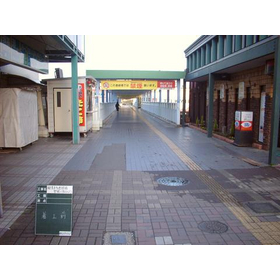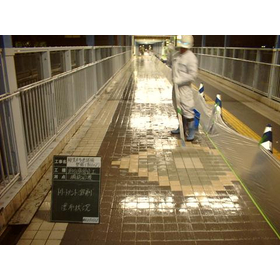Construction example: Pedestrian deck (connecting bridge) tile floor anti-slip (Slip Out ME method)
In December 2008, slip-resistant processing was performed on the tile (clinker tile) floor of the pedestrian deck (connecting bridge corridor) at Toga Mikita Station on the Senboku Rapid Railway in Sakai City, Osaka Prefecture, using the Slip-Out (ME method). Due to the smooth surface of the clinker tile, it was a dangerously slippery flooring material when wet. The advantage of clinker tiles being easy to clean and maintain was the primary factor contributing to the slipperiness. In response to the administrator's request to suppress slipping without changing the landscape or appearance, we implemented the Slip-Out method to create macro-level holes (widening gaps) in the flooring material. After the completion of the work, it was immediately passable, making it feasible to carry out the work during the limited time from the last train to the first train on the station's connecting bridge.


Inquiry about this news
Contact Us OnlineMore Details & Registration
Details & Registration
Related Documents
Related Links
・This method treats the surface of tiles and natural stones with solvents without compromising their aesthetic appeal, making them less slippery during rainy or humid conditions. ・The construction period is very short, and the site can be opened immediately after construction. The treatment solvent expands the existing gaps on the floor surface, forming a cup-like structure, which, combined with the surface tension of water (preventing molecules from separating) and the capillary phenomenon caused by external pressure (such as feet) on the water surface, helps to reduce slipping.














